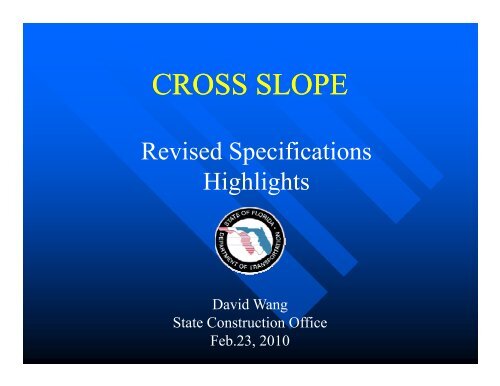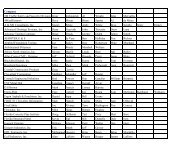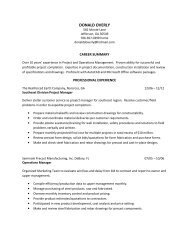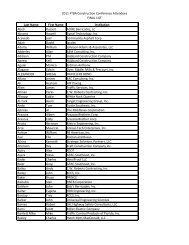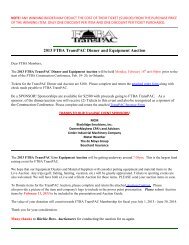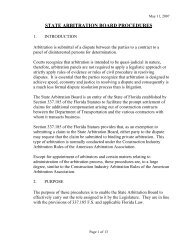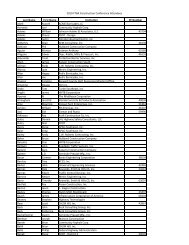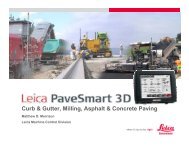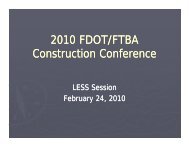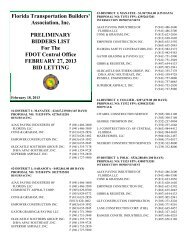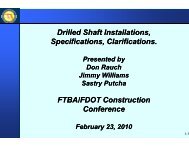Cross Slope - David Wang
Cross Slope - David Wang
Cross Slope - David Wang
You also want an ePaper? Increase the reach of your titles
YUMPU automatically turns print PDFs into web optimized ePapers that Google loves.
CROSS SLOPE<br />
Revised Specifications<br />
Highlights<br />
<strong>David</strong> <strong>Wang</strong><br />
State Construction Office<br />
Feb.23, 2010
Background<br />
A prevalence of cross slope issues was found<br />
during the project reviews of the ACAF<br />
Pavement Awards Evaluation in 2002.<br />
The first cross slope control specification was<br />
developed and implemented in 2003.<br />
Since that specification was used, used there has been<br />
a great improvement in mainline on the tangent<br />
section section, but lack of control on the superelevation<br />
sections.
<strong>Cross</strong> <strong>Slope</strong> Specifications Work Group<br />
A Specifications Work Group was organized to<br />
revise the current Specifications in 2009. 2009<br />
Members:<br />
• FDOT (Paul Steinman Steinman, Greg Sholar, Sholar Stacy Scott, Scott<br />
Alex Mraz, Robert Lopes, Frank Kreis, Richard<br />
Hewitt, Jim Martin, Jimmy Pitman, Sandra<br />
Chitwood, Frank Crawford, Paul Barnes, Emmanuel<br />
Uwaibi, <strong>David</strong> <strong>Wang</strong>)<br />
• IIndustry d (Matt (M Siegel Si l ,Richard Ri h d Dodd, D dd Wayne W Sweet, S<br />
Ken Murphy, Parks Allman, Jim Warren)
Goals of the Work Group<br />
Develop QC and VT processes for Tangent<br />
Section and Superelevated Section for cross<br />
slope control operations.<br />
Develop the requirements for accuracy, accuracy<br />
calibration and comparison check of the cross<br />
slope measuring device.<br />
Finalize the criteria of cross slope acceptance<br />
and removal and replacement of the defect area<br />
on the pavement.
Measuring Device<br />
Electronic level with a length of 4 feet and an<br />
accuracy of 0.1 0 1 degree. degree<br />
Calibration: minimum of once per day before<br />
any paving operation in accordance with the<br />
manufacturer’s instructions.
330 330-12.3.1 12.3.1 Quality Control Requirements<br />
Comparison Check: QC level vs. VT level<br />
• If reading difference between QC and VT is ≤ 0.2%, 02%<br />
the QC level is acceptable for QC measurement.<br />
• If reading difference between QC and VT is > 0.2 %,<br />
perform second comparison check using third<br />
calibrated level (FDOT or Contractor) for resolution.<br />
• If the resolution level compares favorably with the QC<br />
level, the QC level is acceptable.<br />
• If the th resolution l ti level l l does d not t compare favorably f bl with ith<br />
the QC level, reject the QC level.
<strong>Cross</strong> <strong>Slope</strong> Measurement<br />
Place the level at the center of a lane and<br />
perpendicular to the roadway centerline. centerline<br />
Record the measurement to the nearest 0.1 %.<br />
SAFETY<br />
FIRST
<strong>Cross</strong> <strong>Slope</strong> QC Processes<br />
Tangent Sections<br />
• Minimum Frequency: One measurement every 100<br />
feet.<br />
• Calculate the deviation cross slope p at each<br />
measurement (Deviation = Measured cross slope –<br />
Design cross slope) and take the absolute deviation<br />
value l (Always (Al use th the positive iti value l of f deviation). d i ti )<br />
• Average the absolute deviation of ten consecutive<br />
cross slope measurements<br />
measurements.
<strong>Cross</strong> <strong>Slope</strong> QC Processes<br />
Tangent Sections (cont’d)<br />
• When the average absolute deviation cross slope is<br />
consistently within the acceptable tolerance as shown<br />
in Table 330-2 and upon the approval of the Engineer,<br />
the frequency of the cross slope measurements can be<br />
reduced to one measurement every 200 feet during<br />
paving operations.<br />
operations
<strong>Cross</strong> <strong>Slope</strong> QC Processes<br />
Superelevated Sections<br />
• Measure the cross slope every 100 feet per lane within<br />
the full superelevation and calculate the absolute<br />
deviation of measurements.<br />
• Average the absolute deviation of ten consecutive<br />
cross slope measurements.<br />
• For every transition section, measure the cross slope at<br />
control points identified in the Plans, or if not shown<br />
in the Plans, Plans at a control point of 0.0 0 0 % cross slope.<br />
slope
<strong>Cross</strong> <strong>Slope</strong> QC Processes<br />
Superelevated Sections (cont’d)<br />
• For length of full superelevation section less than 250<br />
feet, measure three sections (beginning point,<br />
midpoint and ending point). Calculate the absolute<br />
deviation of each measurement. Average the absolute<br />
deviation of the three cross slopes.<br />
• FFor llength th of f full f ll superelevation l ti section ti greater t than th<br />
250 feet and the number of measurements is less than<br />
10, average the absolute deviations of all the<br />
measurements.
Table 330-2<br />
<strong>Cross</strong> <strong>Slope</strong> Acceptance Tolerance<br />
Roadway Feature<br />
Individual<br />
Absolute<br />
Deviation<br />
Average Absolute<br />
Deviation<br />
TTangent section i<br />
(including turn lanes)<br />
0.4% 0.2%<br />
Superelevated curve 04% 0.4% 02% 0.2%<br />
Shoulder 0.5% 0.5%
Adjust <strong>Cross</strong> <strong>Slope</strong>s on Variable Areas<br />
For intersections, tapers, crossovers, transitions<br />
at the beginning and end of the project, project bridge<br />
approaches and similar areas, adjust the cross<br />
slope p to match the actual site conditions, , or as<br />
directed by the Engineer.
Corrective Actions<br />
Average absolute deviation falls outside the<br />
acceptable tolerance − Stop paving and make<br />
adjustments of the construction operations.<br />
Individual deviation falls outside the acceptable<br />
tolerance − Make corrections per 330-12.5 to<br />
cover the deficient area on structural course.<br />
For multiple layer, the deficient areas may be left<br />
in place, place upon the approval of the Engineer. Engineer<br />
Corrections must be completed before placement<br />
of final surface layer. y
Corrective Actions (cont’d)<br />
Friction Course: Correct deficiencies per<br />
330-12 330 12.5. 5<br />
In the event that the distance between two edges<br />
of deficient areas is less than 100 feet, feet the<br />
correction work shall include the area between<br />
the deficient sections.
Waive Corrective Actions at No Reduction<br />
Submit a request to the Engineer for approval, if<br />
the deficiencies are sufficiently separated so as not<br />
to affect the overall traffic safety, surface drainage<br />
and ride quality q y characteristics of the pavement p<br />
and the corrective action would unnecessarily mar<br />
the appearance pp of the finished ppavement.
330 330-12.3.2 12.3.2 Verification<br />
Randomly measure a minimum of ten cross slopes<br />
per lane per mile in tangent sections, sections control points<br />
in transition sections, and a minimum of three cross<br />
slope p measurements on fully y superelevated p sections<br />
over a day’s production.<br />
If the average absolute deviation or an individual<br />
cross slope deviation falls outside of the<br />
acceptance p tolerance as shown in Table 330-2, ,<br />
immediately make a comparison check at the QC<br />
test locations to verify the QC measurements in<br />
the questionable section.
330 330-12.3.2 12.3.2 Verification (cont’d)<br />
If the comparisons are beyond the acceptable<br />
comparison tolerance (± 00.2%), 2%) stop the paving<br />
operations until the problem is resolved to the<br />
satisfaction of the Engineer. g<br />
Correct any cross slope not meeting the<br />
individual deviation acceptance tolerance in<br />
accordance with 330-12.5 at no cost to the<br />
Department. p<br />
The Engineer reserves the right to check the<br />
pavement p cross slope p at any y locations, , any y<br />
time.
327 327-3.2 3.2 QC Requirements (Milling)<br />
Same requirements as Section 330-12.3 :<br />
Type Type and Accuracy of the Measuring Device<br />
Calibration and Comparison Check<br />
QC and VT Processes<br />
Corrective Actions<br />
Waive Corrective Actions at No Reduction<br />
Adjust j <strong>Cross</strong> <strong>Slope</strong>s p<br />
on Variable Areas
Table 327-1<br />
<strong>Cross</strong> <strong>Slope</strong> Milling Acceptance Tolerance<br />
Roadway Feature<br />
Individual<br />
Absolute<br />
Deviation<br />
Average Absolute<br />
Deviation<br />
TTangent section i<br />
(including turn lanes)<br />
0.4% 0.2%<br />
SSuperelevated perele ated curve c r e 04% 0.4% 02% 0.2%<br />
Shoulder 0.5% 0.5%
CONCLUSION<br />
<strong>Cross</strong> slopes of roadway pavement play an<br />
important role in the ride quality, pavement<br />
drainage, traffic safety and pavement life<br />
preservation. Therefore, careful attention<br />
must be accorded to the accuracy of cross<br />
slopes from the design phase through the final<br />
construction stage.
Thank Thank You<br />
You


